 |
||
|
||
| ||
It has already 2 years passed when AGP-port entered computer realm and became so important that PCI-cards are now nearly forgotten. If you take a look at an average computer, then, beside indispensable Celerons and 440BX chipsets, you'll see an AGP-slot there. Of cause, PCI-video card has no place here. So, what is the reason to recall such an "anachronism" as a PCI-video card? Moreover, there is no need to use new PCI-video cards on old platforms (before-AGP-epoch, that is Socket5,7 systems on 430FX,HX,VX,TX chipsets etc.), since it's not beneficial to use such combination as weak processor + powerful accelerator. However, there is a variety of computers with a rather powerful processor and without an AGP-port. First of all, they are the computers with i810 based mainboard. Such boards have a lot onboard stuff (graphics, sound) and they lack of an AGP-port. Such computers are intended mostly for office use and have little possibility of 3-dimensional games because of limited integrated graphics adapter. For such system a powerful accelerator is unnecessary. But sometimes office clerks don't mind to play a little :-). Besides, i810-boards based computers are bought not only for offices, but for home use as well since they are low-cost and quite powerful again for business applications or educational purposes. As I have already mentioned, an integrated in i810 videoadapter shouldn't be used for 3D-games because of its slowness and limited video memory size. That's why some time later you'll have to upgrade it. Does it make sense to change all the stuff inside, that is a mainboard, and buy a video card separately, or the i810 based board will serve more with a new modern PCI-video card? Sure, there is no simple answer, since the initial aims of purchasing it can differ. If you are not allowed by your boss to relax in your spare time, there is one way out possible: you will have to buy a PCI-video card at your own expense and install it in your office computer (and in case of discharge you can take the card with yourself). Another situation is when you have got a home computer on the same i810-board, but integrated i752 possibilities are not enough. Sure you won't face any problems if you manage to sell your mainboard, buy a new one with AGP-port and then add an AGP-video card. And what if you have no time for it, and you have to live long with i810 chipset, what then? Of cause, you are to buy a PCI-video card with wider possibilities than that of i752. And then there comes a dilemma - what board to choose? You might know that PCI-variants of popular cards get released much later and cost much more. Besides, there is practically no choice of them as compared with AGP-cards range. Well, in this review we want to meet you with one of the modern video cards with PCI interface based on a popular GPU GeForce2 MX. The most positive is that the price for it is comparable with its AGP-variant. So, today' video card is Inno3D Tornado GeForce2 MX PCI from Innovision Multimedia. And simultaneously with considering this unique card (today there is practically no video cards with such power and features of PCI) we continue talking about series video cards based on GPU GeForce2 MX, which are already available in the market. Today we are considering not just a card on GeForce2 MX, but the card with PCI interface, which can give out lots of surprises. BoardInno3D Tornado GeForce2 MX PCI specs:
Her is the card itself : 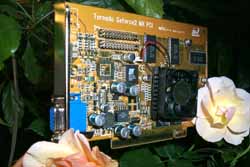  The card is equipped with AGP2x/4x interface, 32 MBytes 6 ns SDR SDRAM located in 4 chips on the right side of PCB:  The chips of memory are produced by Samsung and works at 166 MHz. The card is supplied with a usual active cooler which possesses a large number of blades. But it was mostly the fan itself that surprised me. Today market offers a lot of video cards on GeForce2 MX with only a radiator provided (because of a low chip heat). Moreover, Creative ships its video card on this GPU without even a heat sink. But nevertheless, Inno3D Tornado GeForce2 MX PCI has got an active cooler, so you may hope for a good overclocking. Besides, you can see that the card is designed differently from the reference one, first of all it concerns memory chips location. On the rear side of PCB there are blank spaces for additional memory chips, it means that you may add memory up to 64 MB. PCB provides a blank space for a jack for digital monitors. The video card is enclosed in bright designed box:  The complete set includes not only user's manual and CD with drivers and utilities, but some more discs:
Besides, the CD with drivers and utilities offers a full version of MadOnion 3D Mark2000 Pro. And as a bonus there are 2 packs of note-paper with the company's logo. I can't help praising the company for such a rich compete set! OverclockingUnlike NVIDIA GeForce256 SDR based video cards with 5 ns memory chips which work at underfrequency of 166 MHz, here we have 6 ns memory chips working at its rated frequency (166 MHz). So, we shouldn't expect the overclocking to be as high as we want. Nevertheless, we managed to make the memory work at 200 MHz. The graphics core was overclocked up to 200 MHz, and it's far not a cutoff for GeForce2 MX. There is every reason to expect some performance gain especially in 32-bit color. Installation and driversNow comes a practical part of our review. First comes our test system configuration:
The company supplies its reference drivers of 5.22 version from NVIDIA. In our tests we used 6.35 beta drivers from NVIDIA. Test resultsLet's start with 2D-graphics. Earlier I stressed on perfect quality and decent speed in 2D-graphics which were shown by GeForce2 MX based cards from NVIDIA. But here I must admit that Inno3D Tornado GeForce2 MX PCI doesn't reveal brilliant 2D quality. Of cause, it may be a problem of this definite sample, but vertical stripes can be seen on the photo of display, which was made with a digital camera: 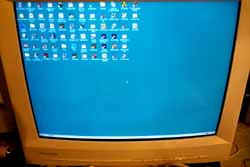 It worsens a bit a general impression. Although, all the other results in 2D are comparable. The following 2 games will help us to estimate speed rates of Inno3D Tornado GeForce2 MX PCI in 3D-graphics:
With these tools we will show you the video card performance via two main API. Beside this card, there are diagrams for two other video cards: ELSA ErazorX (based on NVIDIA GeForce256 SDR) and reference card NVIDIA GeForce2 MX. Then, you may see the performance gain of Inno3D Tornado GeForce2 MX PCI in overclocking mode. 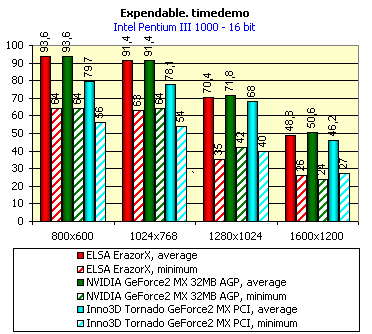  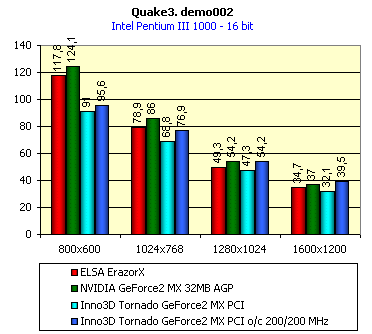 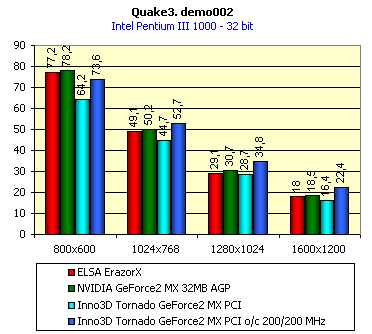 It's easy to notice that performance results of Inno3D Tornado GeForce2 MX PCI video card is a little worse than that of its analog with AGP interface, though the difference is insignificant. Overclocking of Inno3D Tornado GeForce2 MX PCI ensured quite considerable speed increase. Note that the card from Innovision Multimedia worked with minimum additional cooling (there was only one additional fan in the system block). Well, I can't generalize the results of this definite card on all equivalent boards. As for DVD-Video, it is similar to all video cards on NVIDIA GeForce2 GTS. An installed InterVideo WinDVD 2000 player worked flawlessly with the board, image quality was marvelous, processor load didn't exceed 28%. Besides, I want to notice with pleasure that 6.* version drivers provide a possibility to enable DVC (Digital Vibrance Control) technology, what allows to obtain bright rich colors and you will really enjoy the image. Unfortunately, I can't show your screenshots demonstrating DVC since this technology brings in correction in color solutions only after frame-buffer processing is competed and data go further to RAMDAC. ConclusionWell, the card Inno3D Tornado GeForce2 MX PCI appears the first specimen of PCI-card of a new generation. They are the most powerful 2D/3D-video cards with PCI interface (of cause excluding 3dfx Voodoo5 5500 PCI since they are too expensive). So, I think that we convinced you that with $105-110 for upgrade of a computer with i810 based mainboard (or Socket7-platforms with the most powerful processor from AMD of K6-2 or K6-2+ series) we are able to obtain an expected result. GeForce2 MX based boards get more and more popular and it means that price/speed ratio is satisfactory for most users. That's why there is every reason to think that owners of computers without AGP ports will be content with such upgrade, and they will be pleased both with 3D quality in games and performance of the card. Highs:
Lows:
Write a comment below. No registration needed!
|
Platform · Video · Multimedia · Mobile · Other || About us & Privacy policy · Twitter · Facebook Copyright © Byrds Research & Publishing, Ltd., 1997–2011. All rights reserved. |